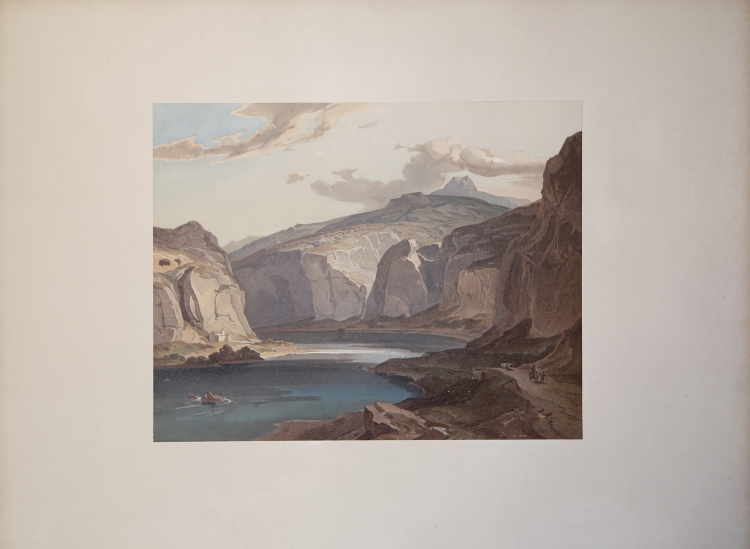



| Reference: | s303130 |
| Author | Carl ROTTMANN |
| Year: | 1875 |
| Zone: | Ceraino |
| Printed: | Munich |
| Measures: | 330 x 250 mm |


| Reference: | s303130 |
| Author | Carl ROTTMANN |
| Year: | 1875 |
| Zone: | Ceraino |
| Printed: | Munich |
| Measures: | 330 x 250 mm |
A beautiful panoramic view of Ceraino Lock, in the region of Veneto.
After a painting by Carl Rottmann.
During 1826/27 Rottmann traveled through Italy in order to enlarge his motif repertoire, which, up until then consisted mainly of local scenery. After his return he was commissioned by Ludwig I to paint a monumental cycle of Italian landscapes in the arcade of Munich's Hofgarten. The cycle, done in fresco-style and completed in 1833, was a visual confirmation of Ludwig's affection for Italy; it raised landscape painting to the ranks of history painting, the King's other preferred genre for large monumental painting commissions.
From Carl Rottmann's italienische Fresken unter den Hofgarten-Arkaden zu München, published in Munchen in 1875.
Chromolitography, in perfect condition.
Carl ROTTMANN (Heidelberg 1797- Monaco di Baviera 1850)
|
Carl Rottmann was King Ludwig I's favored landscape painter. Born in Heidelberg, he received his first drawing lessons from his father and, in 1821, resettled in Munich. During 1826/27 Rottmann traveled through Italy in order to enlarge his motif repertoire, which, up until then consisted mainly of local scenery. After his return he was commissioned by Ludwig I to paint a monumental cycle of Italian landscapes in the arcade of Munich's Hofgarten. The cycle, done in fresco-style and completed in 1833, was a visual confirmation of Ludwig's affection for Italy; it raised landscape painting to the ranks of history painting, the King's other preferred genre for large monumental painting commissions. In 1834 Rottmann received a commission from the King for a second cycle, this time devoted to the landscapes of Greece. Originally conceptualized as well for the Hofgarten arcade, the 23 large landscape paintings were ultimately displayed in the newly built Neue Pinakothek in their own room. Rottmann brought many important aspects to the art of landscape painting. His sketches done from nature and his compositional studies reveal rather a contraction of subject handling and a liberal use of color. His oil paintings, which often served as studies for both large cycles, are, in contrast, not as freely executed, but are rather classically polished and are, above all, informed from the idealized character of the overall composition.
|
Carl ROTTMANN (Heidelberg 1797- Monaco di Baviera 1850)
|
Carl Rottmann was King Ludwig I's favored landscape painter. Born in Heidelberg, he received his first drawing lessons from his father and, in 1821, resettled in Munich. During 1826/27 Rottmann traveled through Italy in order to enlarge his motif repertoire, which, up until then consisted mainly of local scenery. After his return he was commissioned by Ludwig I to paint a monumental cycle of Italian landscapes in the arcade of Munich's Hofgarten. The cycle, done in fresco-style and completed in 1833, was a visual confirmation of Ludwig's affection for Italy; it raised landscape painting to the ranks of history painting, the King's other preferred genre for large monumental painting commissions. In 1834 Rottmann received a commission from the King for a second cycle, this time devoted to the landscapes of Greece. Originally conceptualized as well for the Hofgarten arcade, the 23 large landscape paintings were ultimately displayed in the newly built Neue Pinakothek in their own room. Rottmann brought many important aspects to the art of landscape painting. His sketches done from nature and his compositional studies reveal rather a contraction of subject handling and a liberal use of color. His oil paintings, which often served as studies for both large cycles, are, in contrast, not as freely executed, but are rather classically polished and are, above all, informed from the idealized character of the overall composition.
|